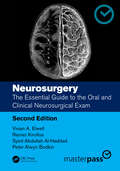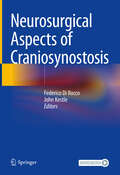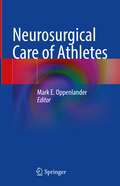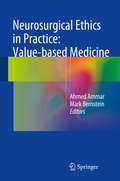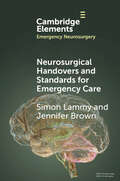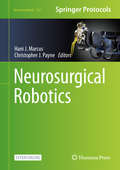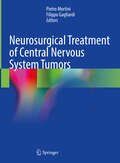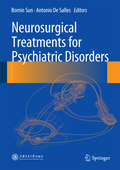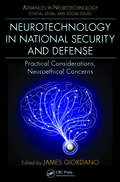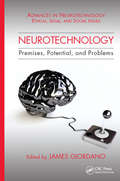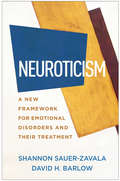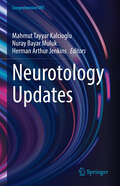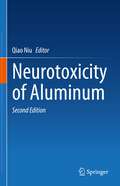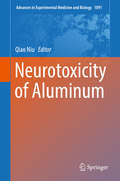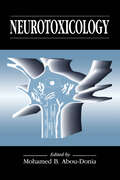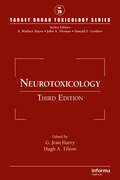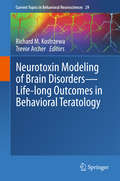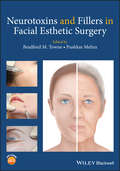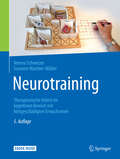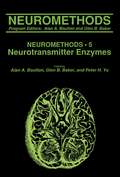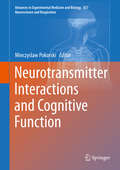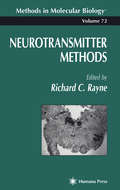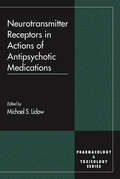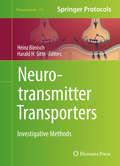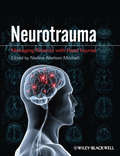- Table View
- List View
Neurosurgery: The Essential Guide to the Oral and Clinical Neurosurgical Exam (Master Pass Series)
by Vivian A. Elwell Ramez Kirollos Syed Abdullah Al-Haddad Peter Alwyn BodkinThis new edition of Neurosurgery: The Essential Guide to the Oral and Clinical Neurosurgical Exam provides a concise and practical guidebook of the core knowledge and principles for the International and Intercollegiate FRCS Specialty Examination in Neurosurgery. It is a vital resource for the American Board of Neurological Surgery (ABNS) and other neurosurgical examinations around the world. Written by neurosurgeons at the top of their field and based on new guidelines, this book takes students through how to succeed in the FRCS neurosurgery exams and provides an overview of crucial short and intermediate cases designed to mirror the exam’s testing of a candidate’s clinical knowledge, diagnostic acumen, investigation and interpretation, treatment options and taking consent. Including 72 vital online revision flash cards, covering critical and diverse examination cases from trauma to paediatric spine exams, this edition also contains crucial guidance to Vivas on the following: Operative surgery and surgical anatomy Investigation of the neurosurgical patient The non-operative clinical practice of neurosurgery This book is a must-read for candidates preparing for the final Intercollegiate Specialty Examination in Neurosurgery (UK), International FRCS Specialty Examination in Neurosurgery (UK) International FRCS Specialty Examination in Neurosurgery as well as the American, Canadian, European and Australasian exams. In addition to helping candidates pass their final exams, the book provides wonderful insight into Neurosurgery for Medical Students, Surgical Residents and Neurosurgical Consultants.
Neurosurgical Aspects of Craniosynostosis
by Federico Di Rocco John KestleThe aim of this book is to cover the domain of craniofacial surgery focusing on neurological and neurosurgical issues. It will offer neurosurgeons and allied specialists a practical way to manage these complex and common malformations in a timely and appropriate way. At the same time, they will be provided the knowledge necessary to understand the functional aspects of these diseases, their anatomical and dynamic impact on the underlying cerebral and vascular structures as well as the cerebrospinal fluid pathways, to overcome the limits of the mere morphological and esthetical correction. Written by experts in the field, the book will represent a reference resource not only for pediatric neurosurgeons and plastic and reconstructive maxillofacial surgeons, but also for all neurosurgeons, residents, and fellows working in this area.
Neurosurgical Care of Athletes
by Mark E. OppenlanderThis book provides a modern and up to date overview of the evaluation and management of sports-related neuro trauma. The primary target audience is the “sports neurosurgeon,” who can be found on the sidelines of collision sports at all levels of play from high school to professional, or who may care for these athletes in the acute setting in hospital or the outpatient clinics. The reach of this book, however, will also extend to professionals in other fields of medicine due to some topics that extend outside the typical neurosurgical specialty, ranging from chiropractic care in the evaluation and treatment of elite athletes to alternative medical therapies for concussion. The importance of the emerging “sports neurosurgeon” subspecialty is exemplified by the adoption of a policy by the National Football League to require an Unaffiliated Neurotrauma Consultant on-field for player safety. This policy also speaks to the recent public awareness of the importance of recognizing and treating sports-related neuro trauma. This text aims to capitalize on this trend and become a multi-specialty reference to anyone interested in the field. Neurosurgical Care of Athletes serves as a comprehensive resource for physicians and researchers involved in sports-related neuro trauma. All chapters are prepared by experts in their fields and include the most up to date scientific and clinical information.
Neurosurgical Ethics in Practice: Value-based Medicine
by Ahmed Ammar Mark BernsteinGood neurosurgical practice is based not only on evidence, skills, and modern equipment, but also on good values. This book is the first to discuss specifically the ethical issues that arise during the daily practice of neurosurgery. It is divided into three parts addressing patients' rights, ethical issues relating to the working environment, and wider societal aspects such as dealings of neurosurgeons with the legal system, the media, and companies. The authors are well-established neurosurgeons who present the ethical problems that they have encountered during their careers and explain what they have learned in confronting these problems. In all, more than 50 neurosurgical cases drawn from real life are reported and discussed from an ethical point of view. This book will be especially informative for young neurosurgeons and will provide all who work in this very special field with a road map on how to avoid violations of medical ethics in neurosurgical practice.
Neurosurgical Handovers and Standards for Emergency Care (Elements in Emergency Neurosurgery)
by Simon Lammy Jennifer BrownOne of the biggest challenges as a neurosurgical trainee is to master the handover. This requires developing an organisational efficiency to concisely relay relevant patient information to a suitably qualified person to execute a given task. A trainee can work extremely hard during an on call, making suitable decisions, implementing previous plans to perfection and covering slack in a team. But if the presentation of this work is unclear then it undoes a lot of that hard work and generates an impression of a trainee being disorganised. Success in a handover requires an understanding of whom you are talking to, what you are saying, how you are saying it and if the way you are communicating gains and maintains interest. Above all a handover should ensure the smooth continuity of care of a patient.
Neurosurgical Robotics (Neuromethods #162)
by Hani J. Marcus Christopher J. PayneThis volume introduces engineers and healthcare professionals to the latest in neurosurgical robotic technology. The chapters in this book are organized into two parts and cover basic engineering concepts that underpin surgical robotics; various robotic platforms and how these systems make their way to the clinic; popular applications of surgical robots in neurosurgery within subspecialties; and a discussion on the future development of neurosurgical robotic systems. In the Neuromethods series style, chapters include the kind of detail and key advice from the specialists needed to get successful results in your clinic. Cutting-edge and thorough, Neurosurgical Robotics is a valuable resources for scientists and engineers interested in learning more about this fascinating and developing field.
Neurosurgical Treatment of Central Nervous System Tumors
by Pietro Mortini Filippo GagliardiIn this book the most recent technical and technological advancements in the treatment of intracranial tumours will be described, and a wide and updated review of the literature on neurosurgical pathologies with high clinical impact will be offered to the readers. Technical nuances and surgical pearls, as well as tricks suggested by the most renowned experts in the field will be explained and illustrated in the light of the most modern approach to oncological neurosurgical pathologies. Each surgical technique will be contextualized in a multi-modal approach to the pathology, defining specific aims and goals of surgery, and a comparative analysis of surgical and clinical results deriving from the different approaches will be systematically discussed, analyzing the specific drawbacks and advantages in approaching the different pathologies, and emphasizing the preservation of patient’s functioning and quality of life as well as the neurological status. Through this book, the editors aim to provide an effective educational support to already trained and experienced neurosurgeons, who want to approach the multi-modal management of intracranial tumors according to the principles of Evidence Based Medicine, highlighting classes of evidence, by using schemes and therapeutic algorithms based on most updated data available in the literature.
Neurosurgical Treatments for Psychiatric Disorders
by Bomin Sun Antonio De SallesThis book describes contemporary clinical practice in the application of neurosurgical methods to the treatment of psychiatric disorders. It covers diverse topics such as neuroimaging, ethics and a historical review, Gamma Knife and High Frequency Ultrasound ablation, deep brain electrical stimulation and preoperative evaluation and postoperative follow-up. Its application in Obsessive Compulsive Disorder, Major Depression, Tourette syndrome, Addiction, Anorexia, Aggression and Schizophrenia are discussed in separated chapters. This book presents concise information provided by clinical and academic practitioners and will facilitate the application of neurosurgical treatment techniques to patients.
Neurotechnology in National Security and Defense: Practical Considerations, Neuroethical Concerns (Advances in Neurotechnology)
by James GiordanoNeurotechnology in National Security and Defense: Practical Considerations, Neuroethical Concerns is the second volume in the Advances in Neurotechnology series. It specifically addresses the neuroethical, legal, and social issues arising from the use of neurotechnology in national security and defense agendas and applications. Of particular concer
Neurotechnology: Premises, Potential, and Problems (Advances in Neurotechnology)
by James GiordanoNew technologies that allow us to investigate mechanisms and functions of the brain have shown considerable promise in treating brain disease and injury. These emerging technologies also provide a means to assess and manipulate human consciousness, cognitions, emotions, and behaviors, bringing with them the potential to transform society. Neurotech
Neuroticism: A New Framework for Emotional Disorders and Their Treatment
by David H. Barlow Shannon Sauer-ZavalaNeuroticism--the tendency to experience negative emotions, along with the perception that the world is filled with stressful, unmanageable challenges--is strongly associated with anxiety, depression, and other common mental health conditions. This state-of-the-art work shows how targeting this trait in psychotherapy can benefit a broad range of clients and reduce the need for disorder-specific interventions. The authors describe and illustrate evidence-based therapies that address neuroticism directly, including their own Unified Protocol for transdiagnostic treatment. They examine how neuroticism develops and is maintained, its relation to psychopathology, and implications for how psychological disorders are classified and diagnosed.
Neurotology Updates (Comprehensive ENT)
by Nuray Bayar Muluk Mahmut Tayyar Kalcioglu Herman Arthur JenkinsThis book provides comprehensive and up-to-date general information and evaluation of the diagnostic and therapeutic options available to individuals suffering from neurotologic diseases. Neurotology is a fast-developing area of science. Even fundamental terminology, such as the meaning of vestibular symptoms, has only recently been established due to the rapid development of vestibular research. This volume discusses the fundamental sciences, and the clinical application of treatments in neurotology, as well as the most recent research. It is aimed at assisting physicians in making the most effective judgments regarding the management of care for their patients. Diagnosing patients with vestibular symptoms such as vertigo, dizziness, unsteadiness, and oscillopsia requires consideration of symptoms and indicators of neurotologic illnesses. The majority of diagnoses may be made right at the patient's side. A grasp of important diagnostic concepts is vital for all practicing neurologists, who regularly assess whether such patients merit immediate diagnostic testing or hospital admission. This book emphasizes understanding how to take a focused medical history and perform a thorough physical examination on a patient experiencing vestibular symptoms or suspected of having a neurotologic condition. This up-to-date reference should be part of the collections of all otolaryngologists, head and neck surgeons, audiologists, neurologists, neurosurgeons, and residents interested in providing the best possible care for patients.
Neurotoxicity of Aluminum
by Qiao NiuThis book reviews the scientific literature and the authors’ own research linking aluminum neurotoxicity with cognitive impairment and Alzheimer’s disease (AD). It focuses on aluminum levels in the brain, region-specific and subcellular distribution, its relation to neurofibrillary tangles and amyloid beta—the pathological features of AD, and the possible mechanism of aluminum inducing these pathological features. Further, the book stresses the importance of aluminum’s complex speciation chemistry in relation to biology, and details aluminum’s mechanism in oxidative stress and cell death, especially in connection with apoptosis and necroptosis. The electrophysiological variation and synaptic plasticity induced by aluminum are covered, while the metal’s debatable role in AD and the cross-talk between aluminum and genetic susceptibility are also discussed, and more recently the relationship between aluminum-induced epigenetic modification on DNA and non-coding RNAs and neuron death and synaptic impairment.The second edition updates eight chapters according to the most recent researches. Content about aluminum-induced AD-like pathological features, neurotoxic effects of aluminum and aluminum alloy nanoparticles(TBD) and alumina nanoparticles induced neurotoxic and neurodevelopmental toxic effects is also added. In closing, this book provides readers with a systematic summary of aluminum neurotoxicity.
Neurotoxicity of Aluminum (Advances in Experimental Medicine and Biology #1091)
by Qiao NiuThis book reviews the scientific literature and the authors’ own research linking aluminum neurotoxicity with cognitive impairment and Alzheimer’s disease (AD). It focuses on aluminum levels in the brain, region-specific and subcellular distribution, and its relation to neurofibrillary tangles and amyloid beta. Further, the book stresses the importance of aluminum’s complex speciation chemistry in relation to biology, and details aluminum’s mechanism in oxidative stress and cell death, especially in connection with apoptosis and necroptosis. The electrophysiological variation and synaptic plasticity induced by aluminum are covered, while the metal’s debatable role in AD and the cross-talk between aluminum and genetic susceptibility are also discussed. In closing, the book reviews the neurotoxic effects of aluminum and its important role in the pathogenesis of AD. Given its depth of coverage, the book provides readers with a systematic summary of aluminum neurotoxicity.
Neurotoxicology
by Mohamed B. Abou-DoniaNeurotoxicology provides a thorough understanding of neurotoxicology through its integration of multilateral ideas covering several disciplines, including chemistry, biochemistry, anatomy, physiology, and pathology. It discusses neurotoxic agents, describes the methods for studying neurotoxic actions, covers factors affecting neurotoxicity, and inc
Neurotoxicology (Target Organ Toxicology Series)
by Hugh A. Tilson G. Jean HarryThis new edition presents an integrated approach to neurotoxicology, the study of organisms' responses to changes in their environment and how interruption of the flow of information by chemical exposure causes a wide range of effects - from learning deficits, sensory disturbances in the extremities, and muscle weakness to seizures and signs simila
Neurotoxin Modeling of Brain Disorders -- Life-long Outcomes in Behavioral Teratology
by Richard M. Kostrzewa Trevor ArcherThis book is authored by leading experts who made major discoveries in neuroteratology research focused on modeling human neural developmental disorders. Individual chapters address ADHD (attention-deficit hyperactivity disorder), Lesch-Nyhan disease, psychoses and schizophrenia, autism, and models of Parkinson's Disease and tardive dyskinesia. The effects of perinatal stress and agonist insults on life-long outcomes are addressed, as well as the overall effects of perinatal neurotoxins on development of specific neural phenotypic systems. The book provides a unique compendium on how perinatal insults of various types can produce effects in brain that persist throughout the life span. Researchers can derive insight into experimental approaches in this research field; clinicians can develop insights into the influences of the many noxious and seemingly innocuous substances that might influence brain development in children.
Neurotoxins and Fillers in Facial Esthetic Surgery
by Pushkar Mehra Bradford M. TowneThis book offers a detailed, practical guide to incorporating minimally invasive cosmetic surgery into dental practice. Chapters thoroughly examine all aspects of using these materials in practice, and present step-by-step techniques for injecting and placing neurotoxins and fillers, with specific recommendations for product selection and in-depth information on case management. Anatomical drawings and clinical photographs depict the procedures and concepts described. From patient evaluation, treatment planning, and product selection to techniques, managing complications, and marketing the service, Neurotoxins and Fillers in Facial Esthetic Surgery provides a complete resource for using these techniques in practice. Coverage encompasses facial anatomy, neurotoxins, cosmetic fillers, hyaluronic acid dermal fillers, Radiesse™ calcium hydroxylapatite injectable filler, pearls and pitfalls, and how to build your practice. Offers a complete but easy-to-use-reference on all aspects of how to set up a minimally invasive cosmetic facial surgery service within an oral and maxillofacial surgery practice Surveys the range of products available in detail from an objective viewpoint Presents how-to techniques for injecting and placing neurotoxins and fillers Neurotoxins and Fillers in Facial Esthetic Surgery is an essential reference for any oral and maxillofacial surgeon or general dentist wishing to add minimally invasive cosmetic surgery to their repertoire.
Neurotraining
by Verena Schweizer Susanne Wachter-MüllerEine der wertvollsten epidemiologischen Studien, das Oxfordshire Community Stroke Project, berichtete 1983, daB 1,95 von 1000 Personen pro Jahr an einem ersten Schlaganfall (Apoplexie) erkranken. In dem gleichen Bericht werden 13 wei tere zuverHissige epidemiologische Bevolkerungsstudien zitiert. Die geschatzte totale Inzidenz einschlieBlich der Ruckfalle betrug 2,2 pro 1000 im Jahr. Aufgrund von zahlreichen anderen Studien in GroBbritannien, Danemark, Finnland, der Schweiz und den USA darf angenommen werden, daB die Haufigkeit des Schlag anfalls in den Industriestaaten der westlichen Zivilisationen von Land zu Land nur geringen Schwankungen unterworfen ist. Extrapoliert auf die Schweiz wurde dies bedeuten, daB wir in unserem Land pro Jahr etwa mit 12000 Patienten, die den ersten Schlaganfall oder einen Ruckfall erleiden, zu rechnen haben. Ange sichts der hohen Mortalitatsrate wahrend der ersten 3 Monate nach dem Schlag anfall einerseits und der Tatsache, daB viele Patienten nur leicht erkranken und eine sehr gute spontane Regenerationstendenz zeigen andererseits, ist es nicht ver wunderlich, daB nur ein Teil der Erkrankten besonderer rehabilitativer MaBnah men bedarf. Trotzdem kann man mit Harris (1971) annehmen, daB den Schlagan fall iiberlebende Hemiplegiker etwa 25% aller schwer behinderten Menschen in einer beliebigen Bevolkerungsgruppe in Westeuropa ausmachen. Eine detaillierte australische Studie ergab, daB man auf eine Bevolkerung von 100000 Personen mit jahrlich etwa 110 den Schiaganfalliangere Zeit uberlebenden neuen Schwer behinderten rechnen muB, die dringend einer Krankenhausbehandlung oder einer Rehabilitation in einem spezialisierten Rehabilitationszentrum bedurfen. Bei einer Untersuchung in Azmoos/Kanton St.
Neurotransmitter Interactions and Cognitive Function
by Mieczyslaw PokorskiA host of neurotransmitters and neuroactive substances underlies respiratory regulation in health and disease. The centerpiece of investigations regarding adaptation to hypoxia and sensorial perception has been the dopaminergic system. It is now clear that a complex interaction among various neuroactive substances, rather than a single one, forms the basis of respiratory changes. The research on neurotransmitter interactions provides the knowledge of how the brain functions and a new level of understanding of mind-to-body connection, which opens up avenues for novel therapeutic interventions.
Neurotransmitter Methods
by Richard C. RayneThis outstanding and comprehensive collection of user-friendly protocols is essential for neuroscientists who wish to localize, identify, purify, and/or quantify neurotransmitters. The easily reproducible methods presented cover a broad spectrum of approaches involving cell and organ culture, histochemistry, immunochemistry, in situ hybridization, cell fractionation, liquid chromatography, mass spectrometry, in vivo microdialysis, and voltammetry. These approaches are optimized for use by neuroscientists, are often complementary, and can be employed in tandem with powerful effect.
Neurotransmitter Receptors in Actions of Antipsychotic Medications (Handbooks in Pharmacology and Toxicology)
by Michael S. LidowYears of extensive investigation into neurophysiology, neurochemistry, and behavioral pharmacology have produced an understanding of antipsychotic medication action that is much more refined than the original dopamine hypothesis. New perspectives offer an array of novel drugs - drugs that pose a lower risk of developing tardive dyskinesia, have few
Neurotransmitter Transporters
by Heinz Bönisch Harald H. SitteThis book is a representative survey of the current status of the structure, function, regulation and molecular pharmacology of Neurotransmitter Transporters. It provides an overview of insights generated in the past five years. The volume serves as a useful compendium of current concepts and an inspiring starting point. It is a source for students interested in this emerging field as well as for experienced scientists looking for an update.
Neurotrauma
by Nadine Abelson-MitchellNeurotrauma: Managing Patients with Head Injuries is a comprehensive, holistic, evidence-based approach to the primary, secondary and tertiary care of a person with neurotrauma.Using a patient-centred needs approach to enhance the quality of care of head injured patients, family and carers, this multidisciplinary book enables the reader to apply the knowledge, skills and attitudes learned to the practice of neurotrauma in all settings. It explores:Anatomy and physiology of the brainPharmacology for neurotrauma patientsAssessment of the patient with neurotraumaManagement of neurotrauma in a range of settings including at the scene, in the emergency department, and at the hospitalNeuro-rehabilitationCommunity careNursing management of the patientThis practical resource includes activities, exercises, and ethical and legal considerations throughout, making it ideal reading for all staff working in neuroscience, emergency, critical and rehabilitation settings.
